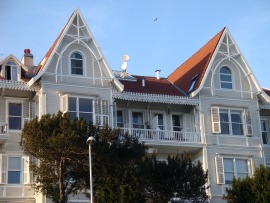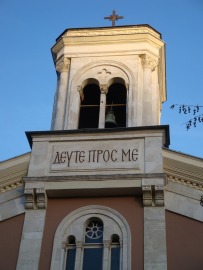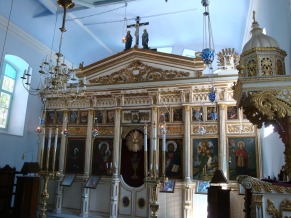“Albanian Village”
Other names: Mega Revma (Greek – Great Current)
When cruising along the Bosphorus it can sometimes be hard to tell the different suburbs apart. Arnavutköy is an exception, its lovely wooden houses a distinctive feature of the waterfront midway between Kuruçeşme and Bebek. But behind Arnavutköy’s innocent appearance lies a story of compulsory resettlement. In the 19th century Sultan Abdülmecid brought men from Albania to help pave the city streets in an early burst of enthusiasm for easing the life of pedestrians. The men were settled in what is now Arnavutköy, hence its name.
Some of İstanbul’s finest Art Nouveau buildings line the waterfront at Arnavutköy. Ironically these lovely houses that now look so individual appear to have been built using ready-made window and doorframes that could be fitted by local builders without the need for expensive architects.
This is not a suburb to visit in search of major sights. Instead it’s a place to relax and amble around the back streets admiring the old houses and dreaming of a more elegant past. Post-Covid, however, you’ll also be dreaming of a scarily affluent-looking life-style too.
Around Arnavutköy
As you approach from Kuruçeşme you will see the imposing double-fronted Ali Vafi (Ayvaz Paşazade) Konaği on the inland side of the road. The road then splits in two, with the main coast road sadly passing between the water and an elegant row of yalıs (waterside mansions), most of them still in good condition.
In the centre of the suburb a small square dominated by a monument to Atatürk is surrounded by yet more yalıs, most of them now turned into restaurants.
 “Come to me” says the inscription in GreekIf you head inland behind the square you will come to the enormous Greek Orthodox Church of Taksiarkis (the Archangels, 1899) with a belltower right over its gate. The church stands over the site of an ayazma (sacred spring). It’s usually kept locked.
“Come to me” says the inscription in GreekIf you head inland behind the square you will come to the enormous Greek Orthodox Church of Taksiarkis (the Archangels, 1899) with a belltower right over its gate. The church stands over the site of an ayazma (sacred spring). It’s usually kept locked.
The church is still larger than the Tevfikiye Cami that was built in 1832 beside an elegant police station, both of them beautifully restored in 2023. They stand at the northern end of Arnavutköy opposite the jutting out promontory known as Akıntıburnu (the Cape of the Current) where the water once flowed so strongly that small boats often had to be hauled around it using towropes. A nice story related by the 16th-century French traveller, Pierre Gilles, claims that the stones lining the shore had been worn smooth by crabs that came ashore to walk round it rather than battle the current.
If you drive inland from Arnavutköy to Etiler you will probably take Sekbanlar Sokak. A diversion along Körkadı Sokak will bring you to a small cemetery facing the domed Greek Orthodox Church of Profitis Elias (Elijah) which has a very beautiful interior.
Transport info
There is a ferry terminal here although services are quite limited outside of commuting hours. (https://www.sehirhatlari.istanbul/).
Almost all the buses travelling up the Bosphorus from Kabataş and Beşiktaş pass through Arnavutköy.
Nearby areas

